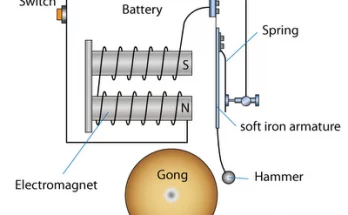NCERT Solutions for Class 7 Science Chapter 10- Electric Current and its Effects provides solutions and detailed explanations for the exercises in the NCERT Class 7 textbook. The article covers essential concepts such as electric circuits, heating and magnetic effects of electric current, and electromagnets. It also suggests creative teaching methods for effective learning. This resource is ideal for students, teachers, and parents looking to master the NCERT Class 7 Science curriculum.
Table of Contents
Chapter 10- Electric Current and its Effects Syllabus Summary-
- Symbols of Electronic Components- Understanding the symbols used to represent common electrical components like electric cells, bulbs, switches, and batteries.
- Electric Circuit and its Components- Learning about electric circuits, including the setup and function of components like cells, bulbs, switches, and wires.
- Heating Effect of Electric Current- Exploring how electric current can heat up a wire and the practical applications of this effect in various appliances.
- Magnetic Effect of Electric Current- Understanding how electric current can make a wire behave like a magnet, and the concept of electromagnets.
- Electric Bell- Studying the mechanism of an electric bell, which uses both the magnetic and heating effects of electric current.
Teaching Methods-
- Interactive Experiments- Conduct simple experiments such as building a basic electric circuit to demonstrate how an electric current flows and lights a bulb.
- Demonstration of Electromagnets- Create an electromagnet using a battery, nail, and coil of wire to show the magnetic effect of electric current.
- Use of Models and Diagrams- Employ models or diagrams to explain complex concepts like the working of an electric bell.
- Video Demonstrations- Show videos that illustrate the heating effect of electric current in real-world applications like electric heaters or toasters.
- Group Activities- Organise group activities where students create simple circuits and electromagnets, fostering practical understanding and teamwork.
- Discussion and Q&A Sessions- Encourage discussion on how electric current affects everyday life, and hold Q&A sessions to clarify doubts.
NCERT Solutions for Class 7 Science Chapter 10- Electric Current and its Effects – pdf
Chapter 10- Electric Current and its Effects – Textbook Exercise -(Solved)
1. Draw in your notebook the symbols to represent the following components of electrical circuits: Connecting wires, switch in the ‘OFF’ position, bulb, cell, switch in the ‘ON’ position, and battery.
Answer-

2. Draw the circuit diagram to represent the circuit shown in Fig.14.21.
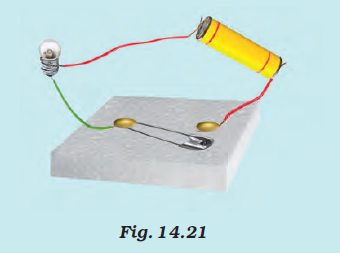
Answer – The circuit diagram corresponding to the figure shows one terminal of the bulb connected to the battery, while its other terminal is linked to a safety pin, serving as a conductor. However, the circuit is incomplete because the other terminal of the battery is not connected to the safety pin, which is necessary for completing the circuit and allowing current to flow. As a result, the switch is in the ‘off’ position, leaving the circuit open.
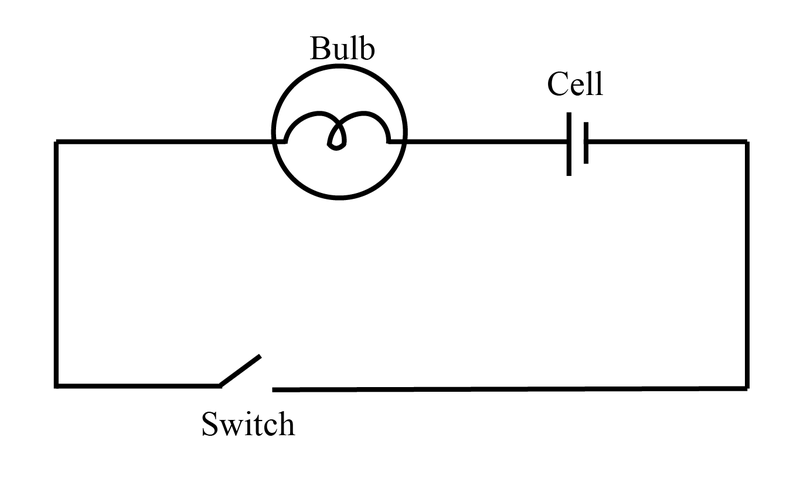
Consequently, in its current state, the bulb will not light up. To illuminate the bulb, the unconnected end of the battery must be linked to the safety pin, thereby completing the circuit.
Also Check- Chapter 10 – Electric Current and its Effects – 5 Worksheets Solved and Unsolved
3. Fig.14.22 shows four cells fixed on a board. Draw lines to indicate how you will connect their terminals with wires to make a battery of four cells.
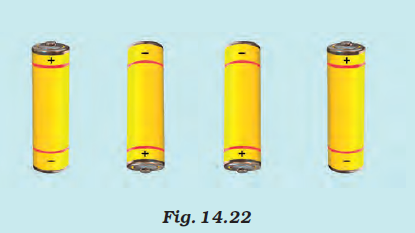
Answer – To create a battery with the four cells shown in Fig.14.22, connect the positive terminal of each cell to the negative terminal of the next cell using wires, and do the same in reverse. This arrangement ensures the proper flow of current through the battery.
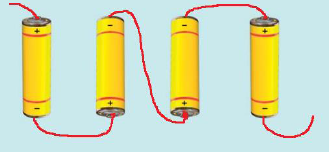
4. The bulb in the circuit shown in Fig.14.23 does not glow. Can you identify the problem? Make necessary changes in the circuit to make the bulb glow.
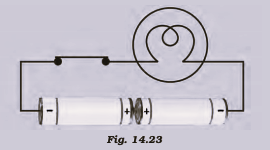
Answer– In the circuit depicted, the issue is that the positive terminals of both batteries are connected to each other. This arrangement prevents the flow of current, leading to the bulb not lighting up. For the current to flow properly and for the bulb to glow, the positive terminal of one cell should be connected to the negative terminal of the other cell, and vice versa. This is because electric current typically flows from the positive terminal to the negative terminal. Adjusting the connections accordingly will enable the circuit to function and the bulb to illuminate.
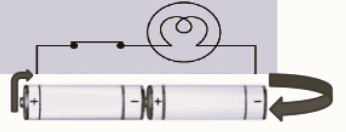
5. Name Any Two Effects of Electric Current
Answer – The two effects of electric current are:
- Heating Effect: When electric current passes through a wire, it generates heat. This is observed in appliances like electric heaters and irons, where the element becomes hot and releases heat due to the current.
- Magnetic Effect: A current-carrying wire behaves like a magnet. This phenomenon was discovered by Hans Christian Oersted. When an electric current passes through a wire, it creates a magnetic field around the wire.
6. When the current is switched on through a wire, a compass needle kept nearby gets deflected from its north-south position. Explain.
Answer – When an electric current is passed through a wire, it creates a magnetic field around the wire. This magnetic field interacts with the magnetic field of the Earth, causing the compass needle, which is sensitive to magnetic fields, to deflect from its usual north-south position. The compass needle aligns with the combined magnetic field created by the Earth and the current-carrying wire. This deflection is a demonstration of the magnetic effect of electric current, showing that electricity can produce magnetic fields just like magnets.
7. Will the compass needle show deflection when the switch in the circuit shown by Fig.14.24 is closed?

Answer- No, the compass needle will not show any deflection in this scenario because the circuit lacks a power source. Without a power source, there is no electric current flowing through the circuit. Since the magnetic effect necessary to cause the deflection of the compass needle arises from electric current, the absence of current means there will be no magnetic field generated to deflect the magnetic needle.
8. Fill in the blanks:
(a) Longer line in the symbol for a cell represents its ________ terminal.
Answer: Positive
Explanation: In the symbol for a cell, the longer line represents the positive terminal, while the shorter line represents the negative terminal. This is a standard representation used in circuit diagrams to differentiate between the two terminals of a cell.
(b) The combination of two or more cells is called a _________.
Answer: Battery
Explanation: When two or more cells are combined together, they form a battery. This can be done in series or parallel to increase the voltage or capacity of the power source. Batteries are commonly used in various devices as a more powerful source of electricity compared to a single cell.
(c) When the current is switched ‘on’ in a room heater, it _______.
Answer: Heats up
Explanation: When the current is switched on in a room heater, it heats up. This is due to the heating effect of electric current, where electrical energy is converted into heat energy. The heater’s element, often made of a high-resistance material like nichrome, becomes hot and releases heat.
(d) The safety device based on the heating effect of electric current is called a ______.
Answer: Fuse
Explanation: The safety device that operates on the heating effect of electric current is called a fuse. A fuse contains a thin wire that melts and breaks the circuit when excessive current flows through it. This prevents potential hazards like fires or damage to electrical appliances by stopping the current flow.
9. Mark ‘T’ if the statement is true and ‘F’ if it is false:
(a) To make a battery of two cells, the negative terminal of one cell is connected to the negative terminal of the other cell. (T/F)
Answer: F
Explanation: This statement is false. To make a battery of two cells, the positive terminal of one cell is connected to the negative terminal of the other cell. This series connection increases the voltage of the combined battery. Connecting negative to negative does not create a functional battery.
(b) When the electric current through the fuse exceeds a certain limit, the fuse wire melts and breaks. (T/F)
Answer: T
Explanation: This statement is true. A fuse is designed to protect electrical circuits by melting and breaking the circuit if the current exceeds a safe limit. The fuse wire is made of a material with a low melting point, allowing it to melt quickly in such situations to prevent damage or fire.
(c) An electromagnet does not attract a piece of iron. (T/F)
Answer: F
Explanation: This statement is false. An electromagnet does attract a piece of iron. When an electric current passes through the coil of an electromagnet, it magnetizes an iron core, turning it into a magnet that can attract iron and other ferromagnetic materials.
(d) An electric bell has an electromagnet. (T/F)
Answer: T
Explanation: This statement is true. An electric bell contains an electromagnet. When the bell is activated, the electromagnet is energized, attracting an iron armature connected to a clapper. This causes the clapper to strike a bell, producing sound. The electromagnet plays a crucial role in the functioning of an electric bell.
10. Do you think an electromagnet can be used for separating plastic bags from a garbage heap? Explain.
Answer – No, an electromagnet cannot be used for separating plastic bags from a garbage heap. Electromagnets attract materials that are magnetic, such as iron, steel, and other ferromagnetic materials. Plastic is not magnetic and does not respond to magnetic fields, making it impossible for an electromagnet to pick or separate plastic bags from a mix of materials.
11. An electrician is carrying out some repairs in your house. He wants to replace a fuse by a piece of wire. Would you agree? Give reasons for your response.
Answer- No, I would not agree to replace a fuse with a piece of wire. Fuses are safety devices designed to protect electrical circuits by melting and breaking the circuit when excessive current flows through them. Using a regular piece of wire, which might not melt as intended, could lead to dangerous situations like electrical fires or damage to the electrical appliances, as it would not provide the necessary protection against overcurrent.
12. Zubeda made an electric circuit using a cell holder shown in Fig. 10.4, a switch, and a bulb. When she put the switch in the ‘ON’ position, the bulb did not glow. Help Zubeda in identifying the possible defects in the circuit.

Answer- To help Zubeda, one should check the following possible defects in her electric circuit:
- Ensure the cell is properly placed in the cell holder with correct polarity.
- Verify the connections are secure and correct at the cell, switch, and bulb.
- Check if the bulb is functional; it might be fused.
- Inspect the switch to see if it is functioning correctly and is in proper contact.
- Examine the wires for any breaks or loose connections that could be interrupting the circuit.
- If the circuit still does not work, try replacing the cell as it may be out of charge.
13. In the circuit shown in Fig. 14.25
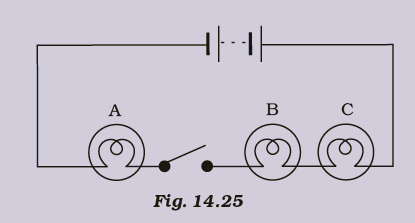
(i) Would any of the bulbs glow when the switch is in the ‘OFF’ position?
Answer – No, none of the bulbs will glow when the switch is in the ‘OFF’ position. This is because the circuit remains incomplete in this state, preventing the flow of electric current necessary to illuminate the bulbs.
(ii) What will be the order in which the bulbs A, B, and C will glow when the switch is moved to the ‘ON’ position?
Answer – When the switch is turned to the ‘ON’ position, bulbs A, B, and C will all light up simultaneously. The design of the circuit allows for an immediate and concurrent flow of electricity to all bulbs as soon as the switch completes the circuit.
Also Check- Batteries- The Powerhouses of Everyday Life – A Guide for Upper Primary Students
Also Check- Electromagnets- A Guide for Upper Primary Students
Also Check- Electric Bell Diagram for Class 7 Science
Also Check- Rapid Revision – Class 7 Science- Chapter 14 – Electric Current and Its Effects
Also Check- Chapter 14- Electric Current and Its Effects-Class 7 science- Question and Answers
Also Check- Chapter 14- Electric Current and Its Effects–Class 7 science- Question and Answer -(Solved MCQs)
Also Check- NCERT Exemplar Solutions- Class 7 Science- Chapter 14 – Electric Current and Its Effects
Also Check- Class 7 science -Chapter 14 – Electric Current and Its Effects- Complete Notes
